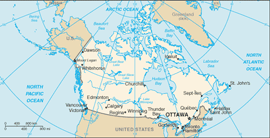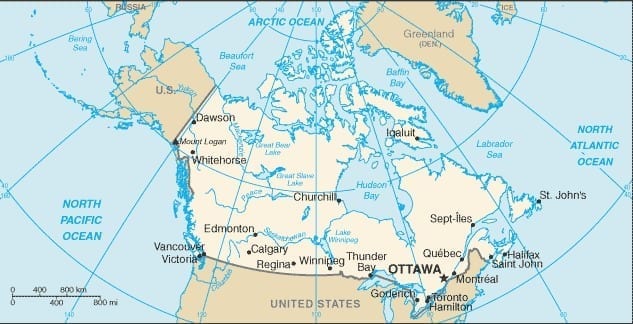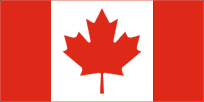Official Name: Canada
Internet Domain: .ca
International Dialing Code: +1
Time Zone: Canada uses six primary time zones. From east to west they are Newfoundland Time Zone, Atlantic Time Zone, Eastern Time Zone, Central Time Zone, Mountain Time Zone, and the Pacific Time Zone. (See Canada Time Zones for precise information on time, time zones and Daylight Savings Times by Canadian province and city)
Location and Size
With an area of close to 10 million sq. km (3.8 million sq. mi.), Canada is the second-largest country in the world, after Russia. It is located in northern North America, bordering the North Atlantic Ocean on the east, the North Pacific Ocean on the west, and the Arctic Ocean on the north.
Government
Canada’s government is a parliamentary democracy, a federation, and a constitutional monarchy. The country is made up of 10 provinces and 3 territories. Canada became a self-governing dominion in 1867 while retaining ties to the British crown.
- Executive Branch: Head of state Queen ELIZABETH II; Governor General Julie PAYETTE; Head of government Prime Minister Justin Pierre James TRUDEAU; cabinet
- Legislative Branch: Bicameral Parliament consisting of the Senate (105 seats) and the House of Commons (308 seats)
- Judicial Branch: Supreme Court; Federal Court of Canada; Federal Court of Appeal; Provincial Courts.
Legal System
Canada’s legal system is based on English common law, except in Quebec where there is a civil law system based on French law. Canada accepts compulsory International Court of Justice (ICJ) jurisdiction with reservations. (What does this mean?)
Canada’s Constitution is made up of unwritten and written acts, customs, judicial decisions, and traditions. The written part of the constitution consists of the Constitution Act of March 29, 1867, which created a federation of four provinces, and the Constitution Act of April 17, 1982, which transferred formal control over the constitution from Britain to Canada, and added a Canadian Charter of Rights and Freedoms as well as procedures for constitutional amendments.
People
Canada is culturally diverse and Canadian immigration policy has historically been open and welcoming, helping to make Canada one of the world’s richest nations. Canadian immigrants are encouraged to retain their cultural identities, traditions, languages and customs.
Nearly 90% of Canadians live within 200 km. of the border with the United States. Thus, the country contains vast expanses of wilderness to the north. Canada’s indigenous peoples make up less than two percent of the population.
Separatist aspirations in the predominantly French-speaking province of Quebec are a major domestic issue. A referendum in 1995 saw advocates of an independent Quebec only narrowly defeated. Subsequent opinion polls indicated a fall in support for independence.
- Population: 35,881,659
- Population growth rate: 0.72% (2018 est.)
- Languages: English (official) 58.7%, French (official) 22%, other 19.3% (2011 Census)
- Literacy: 99% (2019 est.)
- Ethnic Make-up: Canadian 32.3%, English 18.3%, Scottish 13.9%, Irish 13.4%, German 9.6%, Chinese 5.1%, Italian 4.6%, North American Indian 4.4%, East Indian 4%,
- Religions: Catholic 39%, Protestant 20.3% (United Church 9.5%, Anglican 6.8%, Baptist 2.4%, Lutheran 2%), other Christian 6.3%, Muslim 3.2%, other and unspecified 11.8%, None 23.9%, Other 7.3% (2011 census)

Economy
Canada resembles the US in its market-oriented economic system, production patterns and affluent living standards. Since World War II, the impressive growth of the manufacturing, mining, and service sectors has transformed the nation from a largely rural economy into one primarily industrial and urban.
The relationship to its powerful neighbor is a defining factor for Canada. The US and Canada have the world’s largest trading relationship and an unfortified border. Canada enjoys a substantial trade surplus with the US, which absorbs nearly 80% of Canadian exports each year. Canada is the US’s largest foreign supplier of energy, including oil, gas, uranium, and electric power.
Given its great natural resources, skilled labor force, and modern capital plant, Canada has enjoyed solid economic growth, and prudent fiscal management has produced consecutive balanced budgets from 1997 to 2007. In the second half of 2008, growth slowed sharply, a trend that continued in 2009 with a modest recovery toward year-end. The economic decline is primarily due to the global economic downturn, US housing slump, plunging auto sector demand, and a drop in world commodity prices. Public finances are expected to deteriorate for the first time in a decade despite the conservative lending practices and strong capitalization that made Canada’s major banks among the most stable in the world.
- Currency: Canadian Dollar (CAD)
- Leading Markets (2018): US 77.7%, UK 2.7%, Japan 2.3%
- Leading Exports – Commodities: Motor vehicles and parts, industrial machinery, aircraft, telecommunications equipment; chemicals, plastics, fertilizers; wood pulp, timber, crude petroleum, natural gas, electricity, aluminum
- Leading Suppliers (2018): US 52.4%, China 9.8%, Mexico 4.1%
- Leading Imports – Commodities: Machinery and equipment, motor vehicles and parts, crude oil, chemicals, electricity, durable consumer goods
- Top Industries: Transportation equipment, chemicals, processed and unprocessed minerals, food products, wood and paper products, fish products, petroleum and natural gas
- Top Agricultural Products: Wheat, barley, oil-seed, tobacco, fruits, vegetables; dairy products; forest products; fish
Comparative Economic Indicators – 2018
| Canada | USA | Mexico | UK | South Africa | India | |
| Population* (millions) | 38.88 | 329.26 | 125.96 | 65.10 | 55.38 | 1,296.8 |
| Population growth rate* (%) | 0.72 | 0.8 | 1.09 | 0.51 | 0.97 | 1.14 |
| Literacy (%) | 99.0 | 99.0 | 91.0 | 99.0 | 86.4 | 61.0 |
| GDP** (USD billions) | 1,774.0 | 19,490.0 | 2,463.0 | 2,925.0 | 767.2 | 9,474.0 |
| GDP** per capita (USD) | 48,400 | 59,800 | 19,900 | 44,300 | 13,600 | 7,200 |
| Economic growth (%) | 3.0 | 2.2 | 2.0 | 1.7 | 1.3 | 6.7 |
| Inflation (%) | 1.6 | 2.1 | 6.0 | 2.7 | 5.3 | 3.6 |
| Unemployment rate (%) | 6.3 | 4.4 | 3.4 | 4.4 | 27.5 | 8.5 |
| Exports (USD billions) | 423.5 | 1,553.0 | 409.8 | 441.2 | 94.93 | 304.1 |
| Imports (USD billions) | 442.1 | 2,361.0 | 420.8 | 615.9 | 89.36 | 452.2 |
| Currency | Dollar CAD |
Dollar USD |
Peso MXN |
Pound GBP |
Rand ZAR |
Rupee INR |
| Exchange rates (per USD) Jun 2019 | 1.31 | n/a | 19.06 | 0.79 | 14.06 | 68.88 |
| Exchange rates (per EUR) Jun 2019 | 1.49 | 0.88 | 21.62 | 0.90 | 15.93 | 78.06 |
** PPP — Purchasing Power Parity
Credit and Collections
Payments
SWIFT bank transfers are the most commonly used payment method for international transactions. The majority of Canadian banks are connected to the SWIFT network, offering a rapid, reliable and cost-effective means of payment.
Debt Collection
The collection process begins with the issuance of a final notice, or “seven day letter”, reminding the customer of his obligation to pay together with any contractually agreed interest penalties.
Collecting via Legal Action
Within each province, provincial courts hear most disputes concerning small claims, and superior courts hear large claims ” for example, the Quebec superior court hears civil and commercial disputes exceeding CAD 70,000.
Ordinary legal action proceeds in three phases:
- “Writ of summons” whereby the plaintiff files a claim against the defendant with the court;
- “Examination for discovery” which outlines the claim against the defendant and takes into account the evidence to be submitted to the court by each party;
- The trial, during which the judge hears the adverse parties and their respective witnesses in order to clarify the facts of the case before making a ruling.
Except when the judge decides otherwise, each party is required to bear the full cost of the fees of his own attorney no matter the outcome of the proceedings. The rule regarding court costs stipulates that the winning party may demand reimbursement by the losing party based on a statement of expenses approved by the court clerk.
The Quebec civil code has procedures intended to speed up court proceedings. The process includes a standard “originating petition”. Proceedings for “investigation and hearings” must be held within 180 days of the “originating petition”. Judgment must be made within six months after the case was heard and generally encourages the parties to submit to a conciliation stage, with the judge presiding over an “amicable settlement conference”.
Dispute Resolution
Canada is a signatory of the New York Convention of 1958 on the Recognition and Enforcement of Foreign Arbitral Awards. The government has made a decision “in principle: to become a member of the International Center for the Settlement of Investment Disputes (ICSID)“. However, since the ICSID legal enforcement mechanism requires provincial legislation, the federal government must also obtain agreement from the provinces that they will enforce ICSID decisions. Most provinces have endorsed the agreement, but full agreement is unlikely in the near future.
Canada accepts binding arbitration of investment disputes only when it has specifically agreed to do so through a bilateral or multilateral agreement. The provisions of Chapter 11 of NAFTA guide the resolution of investment disputes between NAFTA persons and the NAFTA members. NAFTA encourages parties to settle disputes through consultation or negotiation.
Risk Assessment
Coface Country Rating: A2 — The political and economic situation is good. A basically stable and efficient business environment nonetheless leaves room for improvement. Corporate default probability is low on average.
Coface Business Climate Rating: A1 — The business environment is very good. Corporate financial information is available and reliable. Debt collection is efficient. Institutional quality is very good. Intercompany transactions run smoothly in environments rated A1.
Despite moderate deterioration of their profitability in the current unfavorable economic conditions, companies have in general remained in satisfactory financial health. Vigilance, however, is in order when dealing with companies that have benefited from the boom in mineral and agricultural raw materials in Alberta and the other western provinces. Some firms in Vancouver could suffer from the slowdown of trade with Asia. Manufacturers in Ontario and Quebec that are enmeshed in trade with the United States — the construction and automotive industries in particular — will remain vulnerable despite the beneficial effects of the easing of raw material prices and a weakening Canadian dollar.
Credendo Political Risk Rating: 1 ” Lowest risk (1-7)
Credendo Commercial Risk Rating: A ” Low risk (A, B, C)
Business Climate
Strong economic fundamentals, proximity to the U.S. market, highly skilled employees, and abundant resources are key attractions for American investors in Canada.The North American Free Trade Agreement, involving Canada, the US and Mexico, has brought a trade boom for Canada. However, American tariffs on Canadian timber and increased subsidies for US farmers, have created tension.
With few exceptions, Canada offers full national treatment to foreign investors. Canada is, however, one of the few OECD countries that still has a formal investment review process. Foreign investment is also prohibited or restricted in several sectors of the economy.
Customs Duties and Quotas: Under NAFTA, Canada operates as a free trade zone for products made in the United States. US made goods enter Canada duty free.
Economic Freedom: Canada’s economic freedom score is 80.5 according to the 2019 Index of Economic Freedom (product of The Heritage Foundation). Its economy is the 8th freest behind Hong Kong (#1), Singapore (#2), New Zealand (#3), Switzerland (#4), Australia (#5), Ireland (#6), and the United Kingdom (#7). Canada is ranked 2nd out of three countries in the North America region.
Canada scores very high in eight of the 10 economic freedoms, especially business freedom, property rights, and freedom from corruption. Overall regulation is thorough but essentially transparent, ensuring property rights and the transparent application of the commercial code.
Protection of Property Rights: Foreigner investors have full and fair access to Canada’s legal system. Private property rights are limited only by the rights of national and local Canadian governments to establish monopolies and to expropriate for public purposes.
Canada has not yet ratified key treaties that protect copyright works on the Internet. U.S. (and many Canadian) companies have complained that Canada’s enforcement against counterfeiting and piracy is cumbersome, ineffective and hampered by restrictions on sharing information with rights holders.
Transparency of Regulatory System: The transparency of Canada’s regulatory system is similar to that of the United States. Proposed legislation is subject to parliamentary debate and public hearings, and regulations are issued in draft form for public comment prior to implementation.
Conversion and Transfer Policies: The Canadian dollar is fully convertible.
Corruption: Corruption in Canada is low and similar to that found in the United States. In general, the type of due diligence that would be required in the United States to avoid corrupt practices would be appropriate in Canada. Canada is a signatory to the U.N. Convention Against Corruption.
Political Violence: Political violence occurs in Canada to about the same extent as in the United States.
For more detailed information on these topics, visit the 2018 Investment Climate Statement ” Canada, of the U.S. Department of State.
Business Protocol
Most Canadians have a strong allegiance to their province or region, which can be summed up as follows:
- Atlantic Provinces (Nova Scotia, New Brunswick, Prince Edward Island and Newfoundland): The people are somewhat reserved and provincial and seen as old-fashioned.
- Ontario: This is the business hub and the people tend to be business-like and conservative.
- Western Canada (Alberta, Manitoba and Saskatchewan): The people are open, friendly and relaxed.
- British Colombia: The people are less conventional. This province is often viewed as the Canada of the future.
- Quebec: The French region has a distinct cultural identity. The people are extremely regionalistic/independent.
- North: The people have a strong pioneer spirit.
Appointments: Canadians are punctual. They are also world renowned for their politeness. Because conflict is unwelcomed in Canada, Canadians probably wouldn’t mention it to your face if you are late, but they would undoubtedly remember it.
Business Cards: The giving and receiving of business cards is common practice in Canadian business culture. In Quebec, have one side of your business card translated into French. Hand the card so the French side faces the recipient. Examine any card you receive before putting it in your card case.
Business Attire: Canadians usually dress in dark business suits in the winter and in lighter suits in the spring and summer. Dress codes depend on the context. Like other western countries, dress is becoming increasingly casual; however, the business suit is still de rigueur at a meeting with other professionals.
Names and Titles: Honorific titles and surnames are usually not used. Professional titles are not prominent in business culture, and are generally thought to be pretentious. However, academic titles are important in Quebec and are used with the honorific Monsieur or Madame.
Like other younger cultures, such as America’s or Australia’s, first names are used in Canada both in personal and professional circumstances, even among relatively new acquaintances. Don’t be surprised if your Canadian hosts move quickly to a first-name basis.
Conversation: Communication styles vary most between Anglophone and Francophone parts of the country. Francophones are generally more indirect than Anglophones, although less so than the French. They also tend to be more exuberant than Anglophones.
Canadians communicate more by the spoken word than non-verbal means, which are only used to add emphasis to a message or are part of an individual’s personal communication style.
Gifts: Unlike India or Japan, gift-giving does not play a big role in Canadian business culture.
Meetings and Greetings: Canadian businesspeople often begin relationships in a reserved manner; once people get to know one another they become friendly and informal. Men may offer their hand to a woman without waiting for her to extend hers first.
Negotiations: Canadians tend to be receptive to new ideas. Generally, they are analytical, conceptual thinkers. When presenting information, have facts and figures to substantiate claims and promises. Canadians are essentially rational and logical and will not be convinced by emotions, passion or feelings. Canadians generally dislike negotiation and aggressive sales techniques, tending to value low-key sales presentations.
Acceptable Public Conduct: When speaking to a Canadian, keep an arm’s length distance from the person. Maintaining personal space is important to Canadians. No backslapping, shouting or calling attention to oneself is acceptable. Touching, patting or hugging other men in public is considered socially unacceptable. Your best approach to getting along with Canadians is to remain exceedingly polite, modest, and unpretentious.
Articles of Interest on Canada
Heir not so apparent? Canada and the monarchy
The Economist, October 29, 2009
Why Canada’s Banks Don’t Need Help
Time, November 10, 2009
Sources for further information on doing business in Canada
Doing Business 2019 Canada, PDF available
Doing Business in Canada, Blakes (legal firm)
Embassy Canada in Washington, DC
Invest in Canada, Government of Canada
The American Chamber of Commerce in Canada (AMCHAM Canada Online)
The Embassy of the United States of America
**********
Subscribe to the Credit-to-Cash Advisor
Monthly e-Newsletter — It’s Free
This information is provided by ABC-Amega Inc. Providing international receivable management and debt collection services for exporters to more than 200 countries including XXXX. For further information, contact [email protected].
This report represents a compilation of information from a wide variety of reputable sources.
Economic Indicators: Variety of sources including the CIA World Factbook, Coface Country Rating, Economist Country Briefings, Federation of International Trade Associations (FITA) Country Profiles.
Risk Assessment information: Provided with permission by Coface Country Rating. Also Belgian credit insurance company Ducroire Delcredere
Historical Exchange Rates: OANDA.com The Currency Site.

